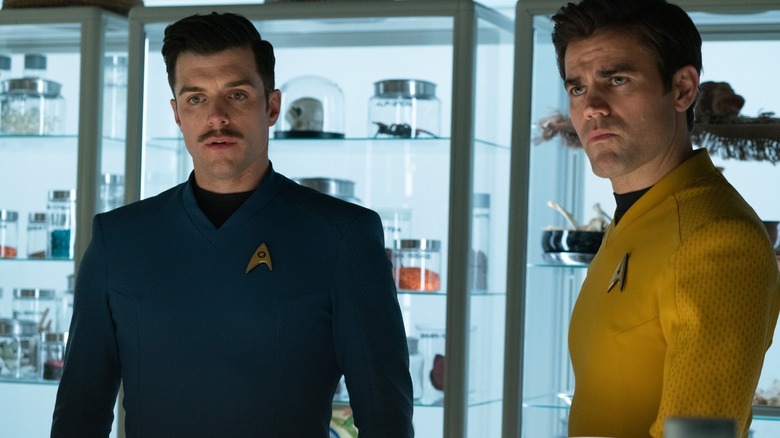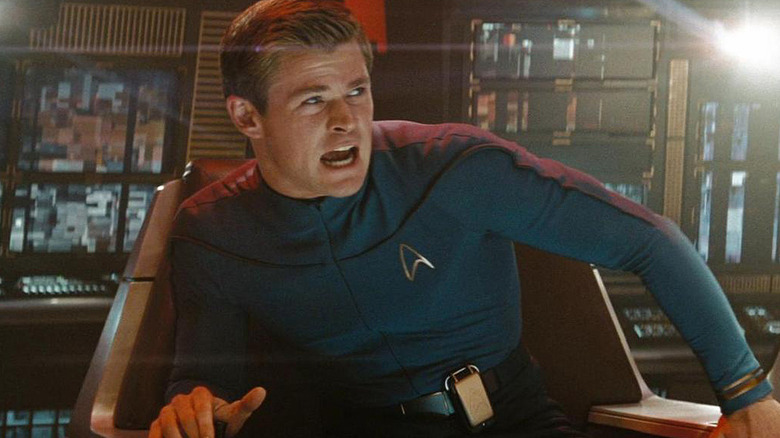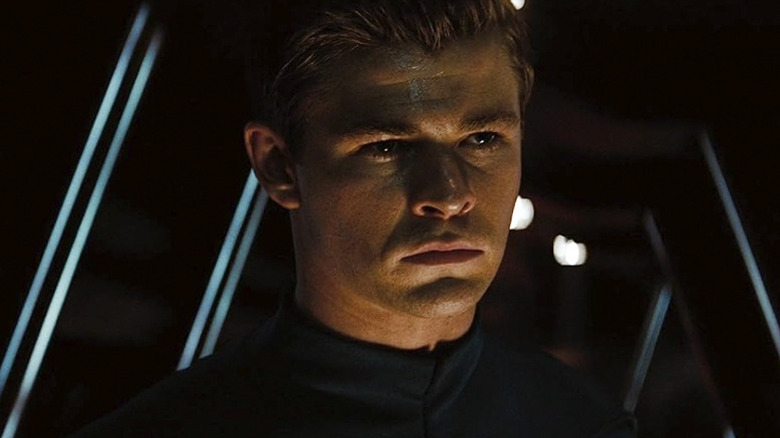Strange New Worlds Just Borrowed A Key Plot Point From J.J. Abrams' Star Trek And Made It Official Canon
In the latest episode of "Star Trek: Strange New Worlds," called "Lost in Translation," a young James T. Kirk (Paul Wesley) has just been promoted to the position of First Officer on board the U.S.S. Farragut. His brother Samuel (Dan Jeannotte) serves on the U.S.S. Enterprise as an anthropologist. In the canon of "Star Trek," James Kirk did indeed serve as First Officer on the Farragut, although Samuel's fate — as detailed in the episode "Operation — Annihilate!" (April 13, 1967) is far less rosy; he and his family will die at the hands (?) of flying pancake-looking critters that invade his planet-bound colony.
The Kirks' father is rarely mentioned in "Star Trek." The most explicit reference to the Kirk patriarch — prior to 2009 — came in a production memo regarding the episode "The Conscience of the King" (December 8, 1966) wherein Kirk (William Shatner) didn't merely witness an infamous massacre at the hands of Kodos the Executioner, but that his dad was murdered as well. This idea was abandoned, and the identity of Kirk's father wasn't made known.
The first time any on-screen mention of Kirk's father came about was in 2009 with the release of J.J. Abrams' "Star Trek." At the start of that film, George Kirk (Chris Hemsworth) was serving onboard a ship called the U.S.S. Kelvin when it was damaged by a Romulan vessel flying in through a portal from the future. George Kirk's son James was born in the middle of the conflagration, and George had just enough time to hear his infant son cry over a communication channel before he crashed the Kelvin into the enemy vessel and died. George Kirk's ship gave the alternate Abrams "Star Trek" timeline its commonly accepted name.
With "Lost in Translation," an element from the Kelvinverse has now become central "Trek" canon.
Reclaiming canon
"Lost in Translation" sees James Kirk's first visit to the Enterprise. The episode features the Kirk brothers bickering — Sam resents that Jim is so darned ambitious — and Jim meets Uhura (Celia Rose Gooding) and Spock (Ethan Peck) for the first time. Sam and Jim talk a little bit about how Jim's ambitions are a direct result of their Starfleet father, George Samuel Kirk, who once served on board a ship called the Kelvin.
And with that passing, almost thrown-off line of dialogue, George Kirk has been placed firmly into "Star Trek" canon as having served on board the U.S.S. Kelvin. One might see the reference as a cheeky need for the central "Trek" timeline to reclaim the Kelvinverse for itself. Note, though, that the Abrams "Star Trek" timeline didn't diverge from the traditional "Trek" canon until the Kelvin was destroyed, so George Kirk's career on board would be canonical either way. It's just that in one timeline he survived, and in another, he died. In the original timeline, Kirk's mother Wynona made it back to Earth and gave birth to James in Iowa. Here, Kirk was born in space.
Of course, Kirk's father has multiple histories, depending on which "Star Trek" novel you decide to pay attention to. Plenty of non-canonical sources have traced careers and personalities around George Kirk. According to the 2015 sourcebook "The Autobiography of James T. Kirk" (the Kelvinverse version of the character), Kirk's father served on board a ship called the U.S.S. Los Angeles before serving on the U.S.S. Kelvin. An early California-class vessel perhaps? Like the ones seen in "Star Trek: Lower Decks"?
Other George Kirk histories
It has generally been accepted that Kirk's father was named George Samuel, although the details of his life have been changed multiple times over the franchise's long and varied expanded-universe history. In Diane Carey's 1999 novel "Best Destiny," a teenage James Kirk has an adventure on the Enterprise with his dad and the ship's captain, Robert April. In that continuity, George Kirk was a Starfleet officer who was frequently away from home. In Joe Haldeman's 1979 novel "World Without End," however, George Kirk was not a Starfleet officer at all, but the mayor of a small Iowa city. In that timeline, George Kirk was an advocate for a return to agrarian life wherein people were to work their own land (and presumably be given the resources to care for farmland).
In the 1989 novel "Final Frontier," also by Carey, it was further posited that George Kirk and Robert April were close friends, and that April asked George to serve on board a brand new experimental starship. In that continuity, George Kirk was the one who suggested it be called the U.S.S. Enterprise. Fatalism! Whee!
William Shatner wrote several "Star Trek" novels himself, detailing a miniature sub-continuity in itself, called the Shatnerverse. In 1997's "The Return," George Kirk was described like a company man, always on business trips, but eager to take his sons to museums and theme parks when he was home. The small Kirk recalls looking at the stars with his father, and credited him for wanting to join Starfleet. In Shatner's version of things, there was no familial tragedy or resentment about Kirk's father.
With "Lost in Translation," though, all other continuities may be cleanly wiped from the map. The U.S.S. Kelvin is real, and George was an officer. Other "official" details will now have to be filled in by the current crop of writers.


